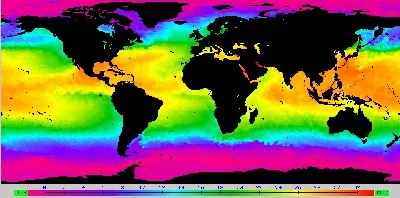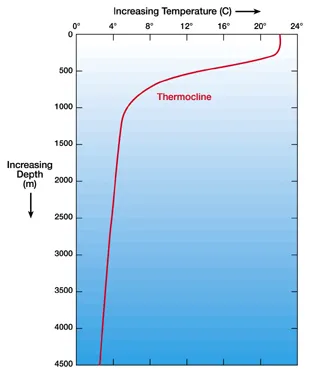Transfer and Storage of Heat in the Oceans

Sea surface temperatures. Pink and purple are coolest (starting near 0º C). Orange and red are warmest (up to around 32º C).
NOAA
Seasonal temperature extremes are milder near large bodies of water and more extreme further inland because water is slower to heat up and cool down than air or even land. The ocean (as well as other large bodies of water) have considerable "thermal inertia." They warm slowly as heat is added, but also give up that heat slowly as their surroundings cool.
Here's an example. The average annual temperatures in Valdivia, Chile, and in Beijing, China are nearly identical. However, the average temperature in the coldest month in Valdivia is 7º C (45º F), while the average in the hottest month is 16º C (61º F). In Beijing, the average temperature in the coldest month is – 4º C (25º F), while the average in the hottest month is 26º C (79º F). The variation from winter to summer in seaside Valdivia is thus a modest 9º C (16º F), while the seasonal variation in inland Beijing is a more extreme 30º C (54º F).
From the surface, the ocean is subdivided based on geography: the Atlantic is distinct from the Pacific which is distinct from the Arctic. But from the perspective of heat in the ocean, the largest subdivision is between the surface ocean and the deep ocean.
Layers of ocean water:
- The surface layer holds about 50 million km3 of water
- The middle "thermocline" region contains about 460 million km3 of water
- The deep ocean has the remaining 890 million km3 of water

Ocean temperature variation with depth, a typical pattern for low to mid-latitude waters.
Windows to the Universe
Sunlight provides a lot of heat to the uppermost layers of the ocean in areas outside the polar regions. The warming sunlight only penetrates to depths of a few tens of meters. Sea surface temperatures range from slightly below freezing near the poles to an annual average near 30° C in the tropics. Wind-driven surface waves and the tides stir the surface layer so the heat is distributed throughout the top few hundred meters of ocean water. Since the surface layer is exposed to the atmosphere, a warming atmosphere can transfer heat to the upper layers of the ocean.
The deeper ocean, which contains about 90% of all ocean water, does not mingle much with the surface layers. Water temperatures in the deep ocean are only between about 0° C and 4° C, and are nearly uniform throughout the world's oceans. Between the surface and deep ocean is a sharp transition between warmer surface called the thermocline at a depth of about a few hundred meters.
Although surface and deep waters are not well-mixed, they do mix gradually over hundreds of years through the movements of a global ocean current (a pattern called thermohaline circulation). Water plunges into the deep ocean in the North Atlantic and around Antarctica and eventually raises some of the cold deep water to the surface in the Pacific and the Indian Ocean. The current generally takes at least a couple hundred years and can last as long as 1,600 to 2,000 years. Warming effects that began early during the Industrial Revolution in the mid-1800s are now being felt in the deep oceans.